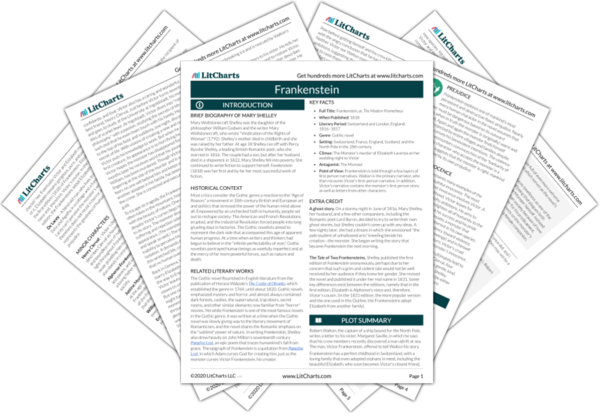Family, Society, Isolation
In its preface, Frankenstein claims to be a novel that gives a flattering depiction of "domestic affection." That seems a strange claim in a novel full of murder, tragedy, and despair. But, in fact, all that tragedy, murder, and despair occur because of a lack of connection to either family or society. Put another way, the true evil in Frankenstein is not Victor or the monster, but isolation. When Victor becomes lost in his…
read analysis of Family, Society, IsolationAmbition and Fallibility
Through Victor and Walton, Frankenstein portrays human beings as deeply ambitious, and yet also deeply flawed. Both Victor and Walton dream of transforming society and bringing glory to themselves through their scientific achievements. Yet their ambitions also make them fallible. Blinded by dreams of glory, they fail to consider the consequences of their actions. So while Victor turns himself into a god, a creator, by bringing his monster to life, this only highlights his…
read analysis of Ambition and FallibilityRomanticism and Nature
Romantic writers portrayed nature as the greatest and most perfect force in the universe. They used words like "sublime" (as Mary Shelley herself does in describing Mont Blanc in Frankenstein) to convey the unfathomable power and flawlessness of the natural world. In contrast, Victor describes people as "half made up." The implication is clear: human beings, weighed down by petty concerns and countless flaws such as vanity and prejudice, pale in comparison to nature's…
read analysis of Romanticism and Nature
Revenge
The monster begins its life with a warm, open heart. But after it is abandoned and mistreated first by Victor and then by the De Lacey family, the monster turns to revenge. The monster's actions are understandable: it has been hurt by the unfair rejection of a humanity that cannot see past its own prejudices, and in turn wants to hurt those who hurt it. As the monster says when Felix attacks it and flees…
read analysis of RevengePrejudice
Frankenstein explores one of mankind's most persistent and destructive flaws: prejudice. Nearly every human character in the novel assumes that the monster must be dangerous based on its outward appearance, when in truth the monster is (originally) warm and open-hearted. Again and again the monster finds himself assaulted and rejected by entire villages and families despite his attempts to convey his benevolent intentions. The violence and prejudice he encounters convinces him of the "barbarity of…
read analysis of PrejudiceLost Innocence
Frankenstein presents many examples of the corruption of youthful innocence. The most obvious case of lost innocence involves Victor. A young man on the cusp of adulthood, Victor leaves for university with high hopes and lofty ambitions. He aims to explore "unknown powers" and enlighten all of humanity to the deepest "mysteries of creation," but his success and his pride brings an end to his innocence. He creates a monster that reflects back to…
read analysis of Lost Innocence






